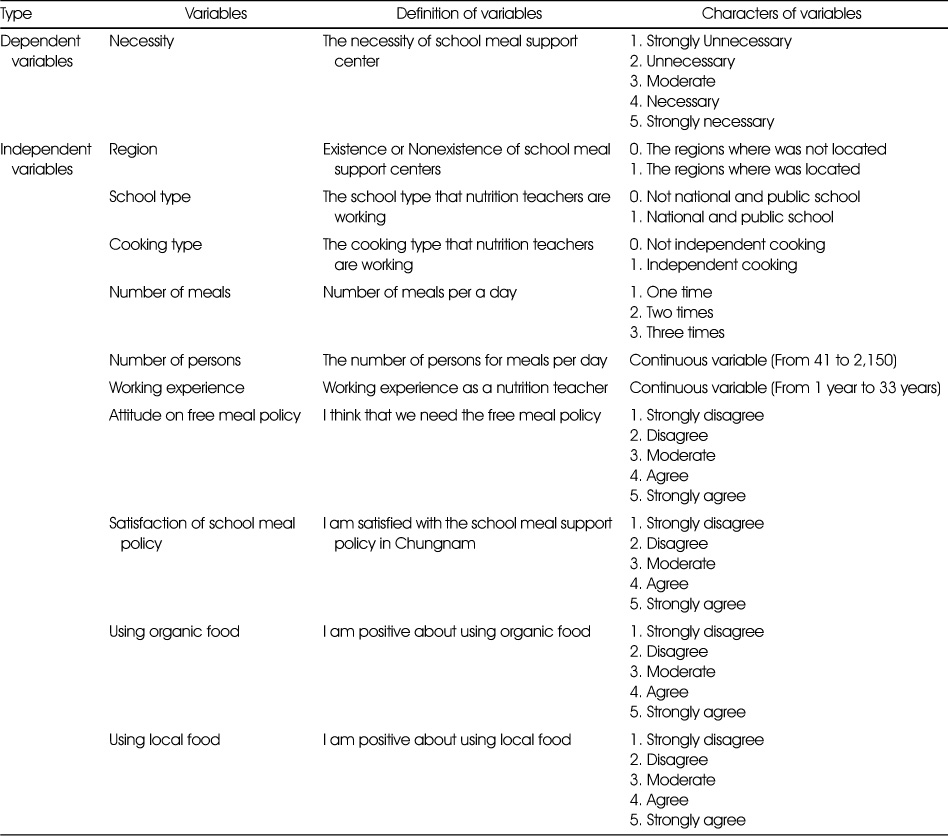Articles
- Page Path
- HOME > Korean J Community Nutr > Volume 23(6); 2018 > Article
-
Research Article
- Analysis of Nutrition Teachers' Awareness of Necessity for an Operating School Meal Support Center in Chungnam
-
Jonghwa Kim

-
Korean Journal of Community Nutrition 2018;23(6):506-515.
DOI: https://doi.org/10.5720/kjcn.2018.23.6.506
Published online: December 31, 2018
Department of Public Admin&Welfare, Chungnam Institute, Gongju, Korea.
- Corresponding author: Jonghwa Kim. Department of Public Admin&Welfare, Chungnam Institute, 73-26 Yeonsuwon-gil, Gongju, Chungnam 32589, Korea. Tel: (041) 840-1128, Fax: (041) 840-1239, sdart@cni.re.kr
Copyright © 2018 The Korean Society of Community Nutrition
This is an Open-Access article distributed under the terms of the Creative Commons Attribution Non-Commercial License (http://creativecommons.org/licenses/by-nc/3.0/) which permits unrestricted non-commercial use, distribution, and reproduction in any medium, provided the original work is properly cited.
- 331 Views
- 0 Download
Abstract
-
Objectives
- We investigated the operation needs of school meal support centers (SMSC) in Chungnam-do based on analysis of nutrition teachers' perception of them.
-
Methods
- The Chungnam government established the first SMSC in 2012. Thirteen SMSCs are currently being operated in Chungnam-do. To analyze the results quantitatively, we investigated nutrition teachers opinions regarding the necessity for SMSCs as a dependent variable and derived the independent variables based on the causal relationships with dependent variables using the ordered logit model. Those independent variables included region, school type, number of students, attitude regarding free meal policy, satisfaction with school meal policy, and preference for local food.
-
Results
- Briefly, teachers in the region in which the SMSC was located more strongly supported the SMSC. In addition, teachers in public schools with a smaller number of students believed that having a SMSC is more beneficial, and that other variables also affected the necessity for SMSCs. Moreover, nutrition teachers preferred local foods rather than organic foods because of the unstable supply of organic foods.
-
Conclusions
- Based on the results of this study, it was recommended that the local government implement the policy consistently. Moreover, it was recommended that the government operate the SMSC more efficiently, enhance the roles of the SMSC as the local organization responsible for student nutritional planing and expand the coverage of agricultural products.
- 1. Dangjin-city. The working materials of operating school meal support center for Dangjin. Dangjin: Dangjin-city; 2012.
- 2. Hong NK, Kim TK. Measuring the willingness to pay for school meal attributes. Korean J Agric Econ 2006; 47(4): 33-49.
- 3. Ha BW, Jang DH. A study on future directions for the establishment and revision of school lunch program ordinances. J Educ Adm 2007; 25(2): 329-352.
- 4. Lee SH, Kim KS, Choi SW. The improvement of operating system for eco-friendly school food service in Gyeonggi-Do. Gyeonggi: Gyeonggi Research Institute; 2011.
- 5. Lee MS, Jeong ST, Hwang SI. A study on the establishment of school meal service system in Jeollabuk-do. Jeonbuk: Jeonbuk Development Institute; 2012.
- 6. Cho HY, Kim MY, Kwon SY, Yoon JH. Current status and suggestions for improvement of school meal service support centers. Korean J Food Mark Econ 2013; 30(3): 139-165.
- 7. Kim OY, Kim H. A case study on operating situations of environment-friendly school food service center managed directly by local government. Korean J Org Agric 2016; 24(1): 45-59.Article
- 8. Cho HY, Kwon SY, Lee YM, Yoon JH. School dietitians' satisfaction with and needs for school meal service support centers. Korean J Community Nutr 2012; 17(2): 194-204.Article
- 9. Lee SW, Yang SB. Effects on a nutrition teacher's satisfaction for the school food service center in the Chungnam province. Korean J Food Nutr 2017; 30(6): 1245-1251.
- 10. Wi TS, Hwang DY, Cheo JS, Jeong HY. Improvement of the food supply system in school food service. Korean J Food Mark Econ 2004; 21(2): 113-137.
- 11. Gouk SY. A study on the improvement and situation of school meal's food supply. Seoul: KREI Agricultural Policy Focus; 2012.
- 12. Ministry of Education. The revised standard plan of school meal support ordinance (2007~2011). Seoul: Ministry of Education; 2006.
- 13. Ministry of Education. The guideline of school meal support center. Sejong: Ministry of Education; 2014.
- 14. Kim JH, Kim JH. The status analysis and development plan of school meal support center in Chungnam. Chungnam Institute; 2016 12. Report No. 2016-16.
- 15. Chungnam prefecture. The working materials of operating school meal support center. Chungnam: Chungnam prefecture; 2018.
- 16. Lee JE, Heo SW. An analysis on the satisfaction and additional cost scale of environmental-friendly agri-product school meal program. Korean J Org Agric 2005; 13(2): 145-159.
- 17. Lee SW, Min SH, Park JY, Yoon SD. The practice on logit & probit model. 1st ed. Seoul: Pakyoungsa; 2005. p. 162-163.
- 18. Woo JY. Analysis of consumer preference of Nonghyup by ordered logit model in the Chungnam province. J Agric Ext Community Dev 2009; 16(2): 405-438.
- 19. Jeong KS, Lee BO. Effect of improvement of beef marketing policy of consumers' preference. Korean J Agric Manage Policy 2012; 39(2): 283-296.
- 20. Toyoda H. The analysis of covariance structure (Ed. Question). 1st ed. Tokyo: Asakura Publishing Co. Ltd; 2003.
REFERENCES
The operating status of Chungnam's School meal support center

1) Source : Chungnam prefecture [15]
Figure & Data
REFERENCES
Citations

The operating status of Chungnam's School meal support center
1) Source : Chungnam prefecture [15]
Operating definition of variables
General characteristics of respondents
1) Existence areas are including Nonsan·Gyeryong, Gongju, Dangjin, Buyeo, Asan, Cheonan, Cheongyang, Hongseong
The analysis results of ordered logit model
1) LR χ2=79.62 (p<0.00), Pseudo R2=0.1507
2) ***: p<0.01, **: p<0.05, *: p<0.1
The measurement of margin effect
Pr: Probability
1) Region and school type are dummy variables
1) Source : Chungnam prefecture [
1) Existence areas are including Nonsan·Gyeryong, Gongju, Dangjin, Buyeo, Asan, Cheonan, Cheongyang, Hongseong
1) LR χ2=79.62 (p<0.00), Pseudo R2=0.1507 2) ***: p<0.01, **: p<0.05, *: p<0.1
Pr: Probability 1) Region and school type are dummy variables

 KSCN
KSCN




 PubReader
PubReader Cite
Cite


